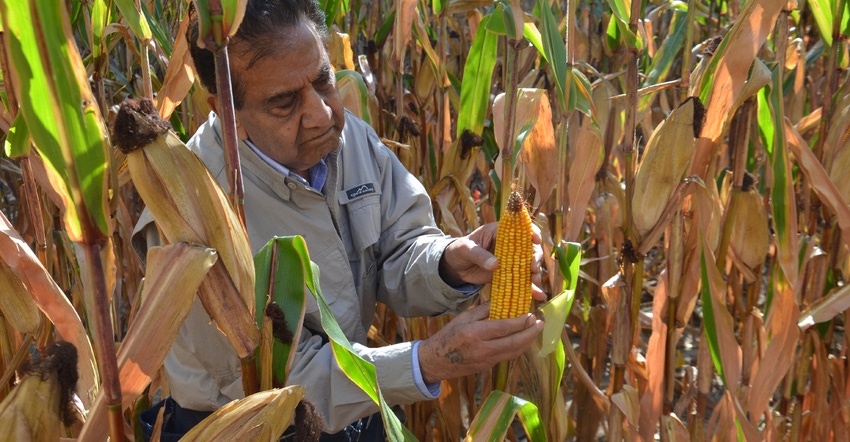December 28, 2020

In 1961, I was 23 years old and eager to learn about corn hybrids. I didn’t want to waste any time after gaining admission at the University of Wisconsin. I arrived in Madison on Aug. 6 from my home in India, where I had done undergraduate training, earned a master’s degree and spent many months on a special project for The Rockefeller Foundation at the Indian Agricultural Research Institute.
Related: Hard work, dedication pave path for corn breeder
D.C. Smith, head of the UW-Madison Agronomy Department, put me to work on the agronomy farms near Madison. Hard work usually pays off. I was the best student in my class in the department that year. Not to brag, but I was selected as one of the top 12 students from different departments to live in the Old Governor’s Mansion — no rent and maid service!
For just under three years, I learned all I could about corn breeding. I learned about hybrid seed development and production at the DeKalb Agricultural Seed Association for 18 months. During my time at DeKalb, I had the good fortune to work with Sherret Chase, director of international operations. Along with learning about DeKalb’s operations in Argentina, Chile, Brazil and Mexico, I worked with Chase’s method of quickly producing inbred lines. It involved doubling of monoploids with the use of “purple embryo” genetic markers.
The system was quick for producing large numbers of genetically uniform, homozygous inbred lines, but not very effective for developing agronomically strong lines. However, some lines developed by the monoploid technique were used in commercial double-cross hybrids.
I was eager to return to India and help the fledgling corn industry there. But there were no jobs available in India for people with my qualifications.
1st job
The family-owned company Edward J. Funk & Sons, Kentland, Ind., sold Super Crost Seeds and was looking for a research director. I was happy to accept that position. This company was owned by four family members. They appeared to have difficulty managing the company. I worked there for three years and then went back to India to personally investigate the job situation there.
My professor in India wasn’t very encouraging about job possibilities. There was virtually no seed industry in India then, and no teaching jobs were available. However, I was lucky to marry Connie, a pretty girl I’d known since childhood. We returned to the U.S. Destiny had different plans for our future!
Trojan Seeds, Olivia, Minn., was trying to buy out Edward J. Funk & Sons, but the deal fell through. Instead, Trojan acquired Crib Filler, owned by Mitchell Farms in Windfall, Ind. They offered me a job as eastern research director. We moved there in 1968. Trojan Seeds was later acquired by Pfizer Genetics Inc.
Next step
I started a new corn research station for Pfizer Genetics on a 40-acre farm in Windfall. Francis Garing and Jeff Hall, two of my best research assistants, joined me at the new research station. Both were intelligent, hardworking and helpful in my future success.
After 12 years at Windfall, I was hunted away by O’s Gold Seed Co. in Iowa as director of research, and later as vice president. O’s Gold was owned by Central Soya of Fort Wayne, Ind., which sold it to Asgrow Seeds. Until then, Asgrow was basically a soybean seed company.
The best years of my life to date were spent in Indiana. So, after a brief stint with Agrigenetics, later called Seedtec International, Eldred, Ill., which was sold to NC+ in Nebraska, I found my way back to Indiana.
Developing new genetics
I joined Stewart Seeds Inc. near Greensburg, Ind., in 1989 as corn research director. Tom and Jim Stewart were very cooperative and encouraging in my corn breeding efforts there. It was a family-owned company, and they had taken over leadership from their fathers, John and Gilman Stewart.
I worked there for about 18 years. With a team of six people, we developed some excellent inbred lines and hybrids. Stewart Seeds started a Genetic Originals brand of corn hybrids that was not available from any other seed company. My most productive years as a corn breeder were spent at Stewart Seeds Inc.
It was during this time that I met Tom Bechman, an editor for Indiana Prairie Farmer. He often came and interviewed me. We would tour my breeding nurseries. This was also the time, around 2000, when I first told him that someday the architecture of corn would change. It would be shorter, and plants would be shaped like Christmas trees to make better use of light.
I predicted then that seeding rates would someday go much higher. In fact, I began seeding at 70,000 seeds per acre in my inbred nurseries to select for genetics with the potential to withstand higher populations. It was meaningful work. Looking back, I was just ahead of my time.
This is the second in a series of articles in which Nanda reflects on his career and changes in the corn breeding industry. Today, Nanda is director of genetics for Seed Genetics Direct, Jeffersonville, Ohio. Email him at [email protected] or call 317-910-9876.
About the Author(s)
You May Also Like






